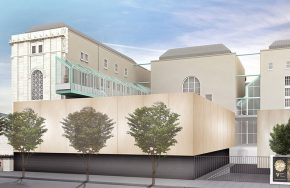Asian Art Museum launches major expansion project designed by Kulapat Yantrasast

The Asian Art Museum, celebrating its 50th anniversary this year, announced plans today to invest in the museum’s future by adding a 12,000-square-foot special exhibition pavilion and by updating and repurposing existing spaces to better serve its audiences. The new pavilion will underscore San Francisco’s cultural diversity, create one of the nation’s premier exhibition spaces dedicated to Asian art, and increase the number of special exhibitions on view for visitors.
Slated to begin work in 2017, the pavilion will add about 9,000 square feet of unified gallery space to the east side of the museum’s first floor. It will sit atop an existing lower-level wing on the museum’s Hyde Street side that was built in the 1990s. The new pavilion will be one of San Francisco’s largest art exhibition spaces.
Also planned is an updating of the museum’s education classrooms to serve 50,000 Bay Area schoolchildren and teachers a year, a third more than the 35,000 school program participants the museum welcomes today. Repurposing other spaces will also create more flexible areas for cultural and community engagement.
The improvements reflect insights gleaned over the 13 years since the museum moved to San Francisco’s Civic Center, its first dedicated home since it opened its doors in 1966 sharing space with the de Young Museum in Golden Gate Park.
“We are a hub for art, education, culture and community,” said Jay Xu, director and CEO of the Asian Art Museum. “We derive our inspiration from the enduring beauty of our superb collection to serve audiences of today and tomorrow. As we envision our next 50 years, we see powerful relevancy in fostering human understanding and cultural appreciation by sharing art and cultural experiences.”
The $25 million project is fully funded by private donations, primarily from members of the board. Over the past two years, the museum has raised more than $50 million to support this capital project, strengthen its operations, and grow its endowment.
To design the pavilion, the museum selected internationally-renowned architect Kulapat Yantrasast and the wHY team based on a competitive interview process. Originally from Thailand, Yantrasast has a track record of creating inviting, beautiful and functional museum environments. The project is in the schematic design phase.
“We are enjoying the process of working with the Asian Art Museum to enhance their physical spaces,” said Yantrasast. “Our team has taken a thoughtful, integrated approach, and we are looking forward to seeing it bring a new dimension to San Francisco’s burgeoning cultural landscape.”
wHY’s design for a stimulating and unified interior space solves several issues that constrain the museum’s presentation of large exhibitions. The current special exhibition galleries are disjointed and not well suited for showing large-scale works of art or contemporary art requiring complex presentation techniques. Importantly, the new pavilion will enable the museum to feature more than one sizable special exhibition at a time, and present more shows from its own celebrated collection which includes art spanning vast regions from China, Japan, Korea and the Himalayas, to South, Southeast and West Asia.
“The significance of the museum is clear when you consider that the combined populations of Asian countries account for more than 60 percent of the world’s population,” said Timothy Kahn, Asian Art Commission vice chair and Asian Art Museum Foundation president. “Art is the universal language of a global community.”
“We pride ourselves in being a museum ‘for all’ and it’s reflected in the diversity you find in our staff, volunteers and visitors,” said Akiko Yamazaki, chair of the Asian Art Commission and the Asian Art Museum Foundation. “Our ‘village’ includes generous donors, the City and County of San Francisco, our commissioners and trustees, staff, museum members, and the more than 600 Bay Area residents who volunteer each year as docents, storytellers, tour guides and service volunteers. We are grateful for and humbled by their shared commitment to our mission.”
Back